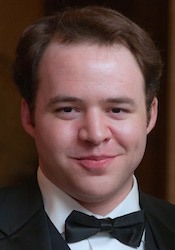Program Information
Evaluation of Artifact-Weighted Groupwise Deformable Image Registration Techniques for the Retrospective Mitigation of Sorting Artifacts in Four-Dimensional Computed Tomography
MJ Riblett1*, GE Christensen2 , GD Hugo3 , (1) Virginia Commonwealth University, Midlothian, VA, (2) Univ Iowa, Iowa City, IA, (3) Virginia Commonwealth University, Richmond, VA
Presentations
SU-F-FS4-5 (Sunday, July 30, 2017) 2:05 PM - 3:00 PM Room: Four Seasons 4
Purpose: To provide proof-of-concept of an artifact-weighted groupwise deformable image registration (AWGR) method that retrospectively corrects 4DCT sorting artifacts to improve image quality.
Methods: The proposed AWGR method adds an axial slice-weight to a groupwise registration approach to mitigate the influence of 4DCT sorting artifacts by down weighting the artifact region and building a motion model from the remaining image content. An artifact-free 4DCT can then be reconstructed from the motion model. Artifact-laden slices can be identified by estimating outlier regions over the time dimension. A synthetic artifact-laden dataset was generated from the images of four subjects in the DIR-LAB 4DCT dataset, to provide images with known sorting artifacts. Sensitivity of accuracy due to weighting scheme (binary step, linear, and Gaussian) was evaluated. The original, artifact-free 4DCT was also registered using an unweighted groupwise approach to yield a reference result. Accuracy was characterized by computing the L1-norm and the RMSE between the transform for each weighting scheme and the reference (artifact-free) registration transform.
Results: L1 norm was 0.0473-0.104, 0.0267-0.146, and 0.0267-0.134 and RMSE was 0.182-0.430, 0.178-0.424, and 0.175-0.541 for the step, linear, and Gaussian weighting schemes, respectively. In the artifact-laden regions only, RMSE was 0.479-0.610, 0.412-0.582, and 0.442-0.709 for the step, linear, and Gaussian weighting schemes, respectively. Reductions in visible sorting artifacts were observed for each method tested.
Conclusion: Artifact-weighted groupwise registration shows potential to correct or reduce the impact of 4DCT sorting artifacts on clinically acquired images. Using a set of synthetic artifact-laden clinical images, AWGR results in visibly improved image quality. Insensitivity of the results to the weighting scheme implies that only coarse artifact detection may be needed for implementation of AWGR.
Funding Support, Disclosures, and Conflict of Interest: This work was supported by a research grant from the National Institutes of Health under Award Number R01CA166119. Hugo receives research support from Philips Healthcare and Varian Medical Systems and has licensed technology to Varian Medical Systems. Christensen has licensed technology to Vida Diagnostics.
Contact Email:
